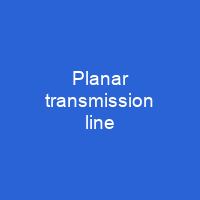Planar Transmission Lines: The Flat World of Microwave Circuits
Imagine a world where circuits are as flat and sleek as the latest smartphone—this is exactly what planar transmission lines offer in microwave technology. These ribbon-shaped lines, first conceptualized during World War II by Robert M. Barrett, have revolutionized how we connect components on printed circuits and integrated circuits at microwave frequencies.
The Evolution of Planar Transmission Lines
Stripline, the earliest type of planar transmission line, was born in 1952. Since then, it has evolved alongside other types such as microstrip, suspended stripline, and coplanar waveguide. Each type offers unique advantages, making them indispensable in various applications.
Types of Planar Transmission Lines
Stripline is a strip conductor embedded between two ground planes, while microstrip places the conductor on top of a dielectric layer with a ground plane below. Coplanar waveguide has return conductors in the same plane as the main line, and finline consists of a sheet of metallized dielectric inserted into a rectangular metal waveguide.
Advantages and Applications
The principal advantage of planar transmission lines is their manufacturability using the same processes as printed circuits and integrated circuits. This makes mass production feasible, reducing costs and increasing efficiency. They are particularly useful at microwave frequencies where individual components are larger than a significant fraction of a wavelength.
Mode of Transmission
The mode of transmission is crucial in understanding the behavior of these lines. The TEM (transverse electromagnetic) mode, characterized by electric and magnetic field strength vectors being transverse to each other and orthogonal to the direction of travel, is dominant on ordinary conductors and some planar transmission lines.
Characteristics and Challenges
Planar transmission lines offer low loss and a better range of characteristic impedance, making them suitable for filters and other applications. However, at higher frequencies, waveguide or dielectric waveguide becomes the technology of choice due to their reduced loss and improved performance.
Manufacturing Considerations
The choice of substrate material depends on the specific application. Substrates like glass-reinforced epoxy, high permittivity ceramic-PTFE laminates, or semiconductor materials are used for different frequencies and requirements. Mechanical properties such as thickness and mechanical strength also play a significant role in performance.
Transitions and Design
Transitions between different types of transmission lines require careful consideration to ensure good impedance match and continuity. This can be achieved by printing microstrip and CPW lines on opposite sides of the substrate or using exponential tapers for smooth integration into waveguide.
Historical Context
The first planar slab dielectric line, imageline, was introduced in 1952. Slotline followed in 1968, and coplanar waveguide in 1969. These innovations led to the development of hybrid MICs (Monolithic Integrated Circuits) and later MMICs (Monolithic Microwave Integrated Circuits).
Planar transmission lines have come a long way since their inception, transforming how we design and manufacture microwave circuits. Their flat geometry and manufacturability make them an essential component in modern electronics, ensuring that our devices remain small, efficient, and powerful.

You want to know more about Planar transmission line?
This page is based on the article Planar transmission line published in Wikipedia (retrieved on December 1, 2024) and was automatically summarized using artificial intelligence.







